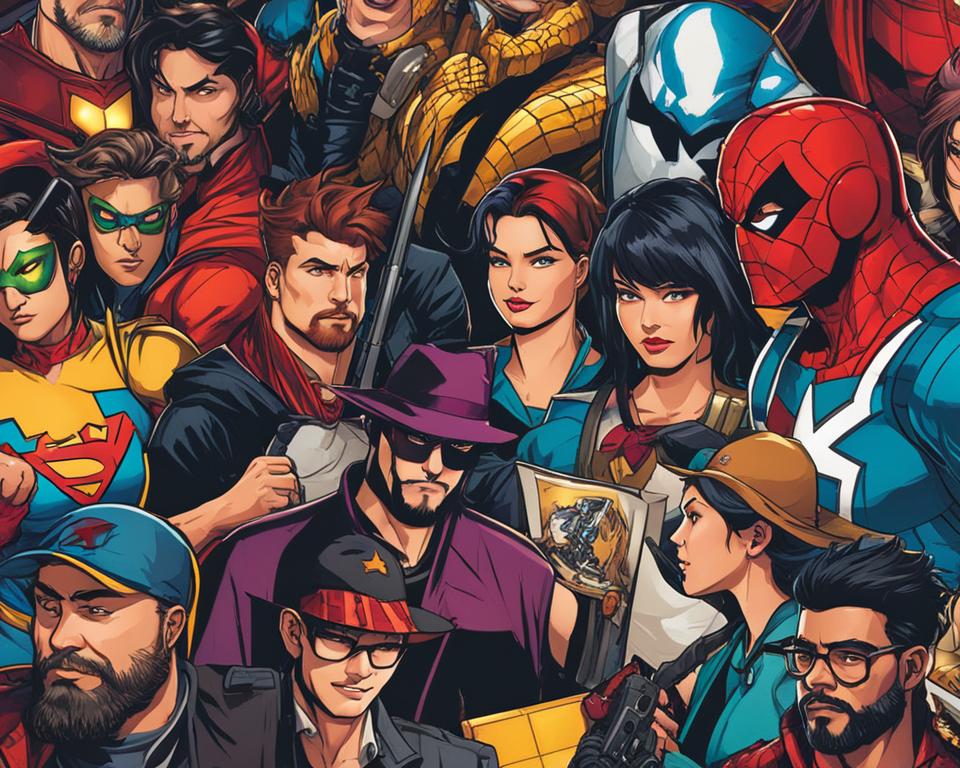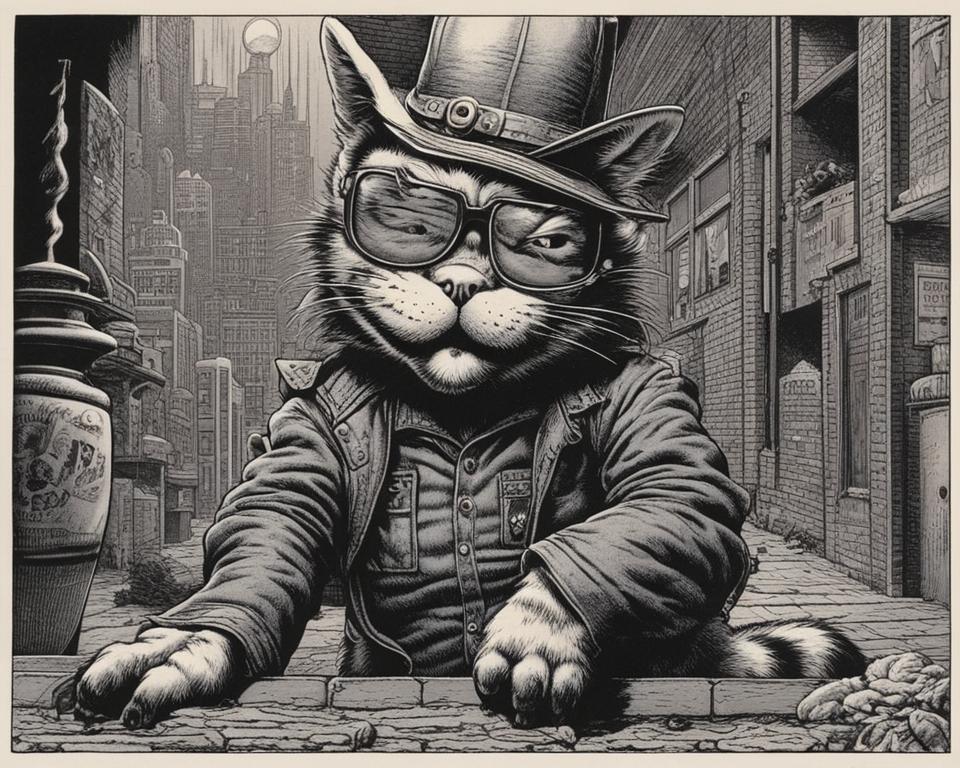
Welcome to our in-depth exploration of the fascinating world of indie comic book creators. In this series, we will take a closer look at the origins of indie comics, delve into the motivations that drive these talented creators, and celebrate the vibrant landscape of independent comics.
Indie comic book creators emerged in the 1970s as a result of changes in the comic book industry. Selling their comics exclusively through specialty shops, these creators carved out a permanent niche for independent comic books in the market. But the origins of comics trace back much further. In fact, it can be traced back to the 15th century when improvements in printing technology led to the popularity of comic strips in newspapers.
DC and Marvel played a significant role in the rise of superhero comics during the Golden Age and Silver Age. It was during the 1960s that Stan Lee’s contributions to Marvel’s success paved the way for indie comic creators to gain recognition. Now, indie comic book creators are an integral part of the comic book industry, offering unique perspectives and storylines outside of the mainstream.
Throughout this series, we will explore how the comic book industry has evolved, the rise of independent artists, the role of comics fandom in the indie revolution, the underground comix era, intellectual property issues, and the impact of psychedelic art and surrealism on underground comix. We’ll also discuss the controversies that have arisen within the indie comic book community and how these challenges have shaped the future of independent comics.
So join us on this exciting journey as we uncover the origins, motivations, and innovations of indie comic book creators. Stay tuned for the next installment in our series, where we delve into the evolution of comics and the rise of independent comics.
The Evolution of Comics and the Rise of Independent Comics
The comic book industry has come a long way, from its humble beginnings as a promotional giveaway to becoming a medium for captivating humor and thrilling adventure stories. However, it was the introduction of superheroes in the late 1930s that truly revolutionized comics, giving birth to iconic characters like Superman and Batman. These characters not only captured the imagination of millions but also laid the foundation for the rise of independent comics.
During the 1960s, a visionary named Stan Lee emerged as a driving force in the comic book industry. Through Marvel Comics, Lee introduced a fresh wave of comic book characters and art styles that cemented his legacy. This revolution sparked newfound creativity among independent artists who sought recognition outside the confines of the mainstream.
Exploring New Horizons: Independent Artists in the Comic Book Industry
Independent artists, fueled by their passion and creativity, began to forge their own paths within the comic book industry. Breaking free from the traditional superhero genre, these artists explored a multitude of genres and experimented with various art forms. Their unique voices and fresh perspectives breathed new life into comic books, offering readers a diverse range of storytelling experiences.
This wave of independent artists opened doors for the exploration of different art styles, pushing the boundaries of what comics could achieve. From realistic illustrations to abstract interpretations, independent artists showcased their versatility and showcased the incredible range of comic book art styles.
The Rise of Comic Book Characters: Diverse Voices and Stories
As independent artists gained recognition, they brought forth characters that reflected the world around them. These characters were diverse in their identities, experiences, and struggles, resonating with a wider audience hungry for representation. From LGBTQ+ superheroes to superheroes from different cultural backgrounds, independent comics became a platform for inclusive storytelling.
The indie revolution gave birth to characters that defied convention, challenging societal norms and addressing important social issues. These characters became relatable icons, influencing readers and inspiring future generations of creators.
To truly appreciate the impact of independent comics, let’s take a closer look at some notable indie comic book characters:
| Character | Publication | Description |
|---|---|---|
| Maus | Art Spiegelman | A groundbreaking graphic novel that tells the story of a Holocaust survivor and his struggles to come to terms with the past. |
| Saga | Brian K. Vaughan and Fiona Staples | An epic space opera that follows star-crossed lovers from warring alien species, challenging societal norms and exploring themes of family and identity. |
| Persepolis | Marjane Satrapi | A memoir in graphic novel form, chronicling the author’s experiences growing up during the Iranian Revolution. |
The indie revolution not only transformed the comic book industry but also paved the way for a new era of creativity and innovation. Independent artists continue to push boundaries, blurring the lines between different art forms and challenging traditional storytelling conventions.
Join us in the next section as we delve deeper into the role of comics fandom in fueling the indie revolution and the impact of underground comix on the industry.
The Role of Comics Fandom in the Indy Revolution

The Indy Revolution of the 1970s, which gave rise to the independent comic book movement, would not have been possible without the active participation and support of comics fandom. Fans played a crucial role in shaping the landscape of independent comics, creating a vibrant community that championed creativity and diversity.
One of the key platforms for fan engagement was the letters pages in comic books. These pages provided a direct line of communication between fans, publishers, and creators. Fans could share their thoughts, offer feedback, and even ask questions to their favorite comic book artists and writers. This exchange of ideas fostered a sense of community and empowerment, giving fans a voice in the development of comic book narratives.
To further connect with like-minded fans, fanzines emerged as a powerful medium. Publications like Alter-Ego served as communication networks, sharing news, interviews, and information about independent comics. Fanzines created a sense of belonging and provided a platform for fans to express their love for the medium.
“Comics fandom gave us a way to connect with people who shared our passion for comics. We could discuss our favorite characters, artists, and storylines, and even contribute our own thoughts through letters and fanzines. It was like being part of a secret club, where we could celebrate the art form we loved.” – Jane, a long-time comics fan
As the Indy Revolution gained momentum, fans took their enthusiasm to the next level by organizing conventions. These gatherings became epicenters of comics fandom, attracting fans from all over the country. Conventions provided an opportunity for fans to meet their favorite creators, attend panel discussions, buy rare comics, and immerse themselves in the world of comics. The energy and excitement of conventions fueled the growth of the indie comic book community.
Comic book specialty shops also played a crucial role in fostering comics fandom. These shops created a physical space where fans could browse, discover, and purchase comics. The knowledgeable staff at these shops not only recommended new titles but also served as a hub of information, discussing the latest releases and upcoming projects. Specialty shops became the beating heart of comics fandom, where fans could connect with fellow enthusiasts and share their passion.
Comics fandom, with its letters pages, fanzines, conventions, and comic book shops, provided the foundation for the success of independent comics. The engagement and support of fans propelled the Indy Revolution forward, allowing independent creators to thrive and bring fresh, diverse stories to the forefront.
| Comics Fandom | Impact |
|---|---|
| Letters Pages | Direct communication between fans, publishers, and creators |
| Fanzines | Sharing news and information about independent comics |
| Conventions | Gathering place for fans, meeting creators, and celebrating comics |
| Comic Book Shops | Physical spaces for fans to connect, discover, and purchase comics |
The Underground Comix Era and Independent Innovation
The late 1960s and early 1970s marked a significant turning point in the world of comics with the emergence of underground comix. Influenced by the youth counterculture of the time, these comix offered readers a rebellious and unconventional alternative to mainstream comics. Sold primarily in head shops, these underground publications tackled taboo subjects such as sex, drugs, and social satire.
The underground comix movement provided a platform for independent creators to explore new artistic styles, genres, and narratives. These comic artists were free from the constraints imposed by large publishers, allowing them to experiment and push boundaries in ways that were previously unheard of in the industry. The result was a diverse range of comics that embraced satire, physical comedy, and unconventional storytelling techniques.
“Underground comix gave artists the freedom to express themselves in ways that weren’t possible within the confines of mainstream comics. We were able to tackle controversial subjects and challenge societal norms, all while providing a unique brand of humor and entertainment,” said Robert Crumb, one of the renowned underground comix artists of the era.
While many underground comix titles had short lifespans, their impact was significant and far-reaching. They laid the foundation for the independent innovation that would shape the future of comics. Through their bold and boundary-pushing work, underground comix artists paved the way for future generations of independent creators.
Take a look at the image below to get a glimpse of the iconic underground comix art style:
| Key Features of Underground Comix: | Examples |
|---|---|
| Satirical social commentary | R. Crumb’s “Zap Comix” |
| Sexual liberation and exploration | Aline Kominsky-Crumb’s “Love That Bunch” |
| Political activism and anti-establishment themes | Art Spiegelman’s “Maus” |
| Physical comedy and slapstick humor | Kim Deitch’s “The Boulevard of Broken Dreams” |
| Experimental art styles and storytelling techniques | Harvey Pekar’s “American Splendor” |
The underground comix era was a groundbreaking period for the comic book industry, pushing the boundaries of what was considered acceptable in mainstream comics. It opened doors for independent creators and revolutionized the way comics were created, distributed, and consumed. The legacy of underground comix continues to inspire and influence comic creators to this day, challenging conventions and bringing unique voices and perspectives to the medium.
Intellectual Property and Comic Creators’ Motivation for Innovation
Comics are not just works of art; they also hold economic value in the creative industry. It is crucial for the comic industry to be recognized as intellectual property and be granted legal protection. The awareness of intellectual property rights and the motivation of comic creators play a pivotal role in driving innovation and the development of comic products.
Comic creators invest their time, skills, and passion into bringing their stories and characters to life. Protecting their intellectual property rights ensures that their creative endeavors are safeguarded and that they can benefit from their creations both artistically and financially.
However, the lack of awareness surrounding intellectual property rights within the comic industry can hinder its growth and potential. Many creators may not fully understand how to protect their work or may face challenges in commercializing their creations due to limited knowledge of legal processes.
Recognizing comics as part of the creative economy is crucial for fostering its development and supporting comic creators. By providing resources, education, and legal frameworks that protect intellectual property rights, the comic industry can thrive and continue to innovate.
Comic creators are motivated by their love for storytelling, their desire to connect with readers, and their passion for the art form. By ensuring their intellectual property rights are respected, they are empowered to explore new ideas, take risks, and create compelling narratives that captivate audiences.
The comic industry’s growth and success depend on the collaboration between creators, publishers, and readers. When creators feel secure in their intellectual property rights, they are more willing to push boundaries, experiment with new storytelling techniques, and take creative risks. This innovation and motivation contribute to the vitality and diversity of the comic industry.
Ultimately, it is essential for the industry as a whole to acknowledge and protect the intellectual property rights of comic creators. By doing so, we can foster a thriving creative ecosystem that encourages innovation, nurtures talent, and rewards the hard work and dedication of comic creators.
Intellectual Property Rights in the Comic Industry
| Benefits of Intellectual Property Rights | Challenges in the Comic Industry |
|---|---|
|
|
By addressing these challenges and providing support to comic creators, we can foster a thriving and sustainable creative industry that continues to push the boundaries of storytelling and captivate audiences worldwide.
The Role of Psychedelic Art and Surrealism in Underground Comix
Underground comix artists played a significant role in the realm of psychedelic art and drew inspiration from Surrealism. These visionary artists found avenues to reach their audience through concert posters and illustrations for underground newspapers and magazines. Psychedelic posters were a fusion of various art styles that beautifully complemented the music of the counterculture. The artists embraced surrealistic motifs and imagery, reflecting their shared interest in the hallucinatory and the extrasensory.
One prime example of the integration of psychedelic art and Surrealism in underground comix is the work of Robert Crumb. His iconic illustrations were often imbued with dreamlike qualities and surreal narratives that captivated readers and challenged societal norms.
“Psychedelic art is about getting high, Surrealism is about waking up.”
These artists leveraged the visual and symbolic language of psychedelic art and Surrealism to push boundaries, expand consciousness, and explore the inner depths of human experience. They used vibrant colors, intricate patterns, and mind-bending perspectives to transport readers into alternate realities where imagination knew no bounds.
The fusion of psychedelic art and Surrealism in underground comix became a channel for self-expression, offering creators and readers alike a unique and immersive experience. Exploring the counterculture and pushing artistic limits, these visionary artists reshaped the landscape of comics and left an indelible mark on the world of art.
Robert Crumb and the Controversies of Underground Comix

Robert Crumb, one of the most popular and talented underground cartoonists, used satire to critique various aspects of society, including the counterculture. However, his work also raised controversies due to its depictions of women and African-Americans. Crumb’s comics often featured violence towards women, reflecting the prevailing sexism of the era. Some of his imagery of African-Americans was racially insensitive, drawing criticism for perpetuating stereotypes. While Crumb’s work was groundbreaking, it also highlighted the need for more inclusive and respectful representation in comics.
Conclusion
Indie comic book creators have revolutionized the comic book industry, bringing forth a diverse range of stories and art styles outside of the mainstream. With origins dating back centuries, it was in the 1970s that independent comics truly flourished, allowing artists to break free from convention and explore new genres. The motivations driving these creators, coupled with the ever-evolving comic book industry, have given rise to a vibrant and dynamic landscape of independent comics.
Looking ahead, the future of indie comic book creators is shaped by their unwavering passion, tireless innovation, and the unwavering support of their fans. These creators continue to push boundaries, challenging the status quo and introducing fresh perspectives to the world of comics. Through their independent spirit, they offer readers unique and engaging narratives that captivate and inspire.
As the indie comic book scene continues to thrive, it is important to recognize and celebrate the contributions of these talented individuals. Their commitment to independent storytelling has opened up new avenues for creativity and artistic expression. So whether you’re a fan of superheroes or exploring alternative genres, make sure to immerse yourself in the world of independent comics and discover the incredible talent of indie comic book creators.
FAQ
When did indie comic book creators emerge?
Indie comic book creators emerged in the 1970s as a result of changes in the comic book industry.
What are the origins of comics?
Comics can be traced back to the 15th century when printing technology improved, leading to the popularity of comic strips in newspapers.
How did DC and Marvel contribute to the rise of comic book characters?
DC and Marvel played a significant role in the rise of superhero comics during the Golden Age and Silver Age, shaping the comic book industry.
What led to the recognition of indie comic creators?
Stan Lee’s contributions to Marvel Comics during the 1960s paved the way for indie comic creators to gain recognition and explore different genres and art forms.
What role did comics fandom play in the Indy Revolution?
Comics fandom, with its letters pages and fanzines, created a communication network among fans and played a crucial role in the success of independent comics.
Where were underground comix sold?
Underground comix were primarily sold in head shops and tackled topics such as sex, drugs, and satire.
How did underground comix inspire independent innovation?
The underground comix movement provided a platform for independent creators to experiment with different styles and genres, shaping the future of comics.
Why is intellectual property important for comic creators?
Intellectual property recognition and legal protection are crucial for the growth of the comic industry and motivating comic creators to innovate and develop their work.
How did psychedelic art and Surrealism influence underground comix?
Psychedelic art and Surrealism inspired underground comix, with artists incorporating various styles and motifs into their work.
Who is Robert Crumb and what controversies surrounded his work?
Robert Crumb is a popular underground cartoonist whose work often raised controversies due to its depictions of women and African-Americans, reflecting the prevailing sexism and racism of the era.
What role did indie comic book creators play in the industry?
Indie comic book creators have played an integral role in the comic book industry, offering diverse stories and art styles that exist outside the mainstream.
Source Links
- https://scholarhub.ui.ac.id/cgi/viewcontent.cgi?article=1094&context=jsht
- http://stevenphilipjones.com/a-history-of-indy-comic-books/
- https://arthistoryteachingresources.org/lessons/comics-underground-and-alternative-comics-in-the-united-states/

